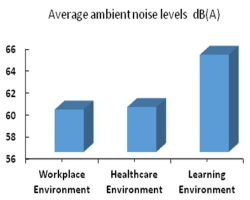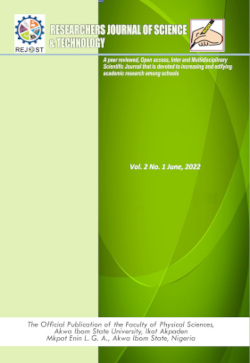Evaluation of acoustic conditions, occupants’ satisfaction and comfort in open -plan offices: a case study of select places in Akwa Ibom State, Nigeria
Keywords:
Open-plan office, acoustic comfort, workplace environment, healthcare environment, learning environmentAbstract
This paper examines the acoustic comfort of occupants of open- plan offices in different indoor environments such as workplace, healthcare and learning environments con-sidering the environmental effects on speech privacy, concentration when under-taking a task and acoustic satisfaction. It has also identified the major sources of office noise that help degrade the indoor qualities of open- plan offices and the possible ways of eradicating or minimising them. Digital sound level meter SL-5868P was used to measure the ambient and background noise levels of these environments to ascertain the relationship between the objective assessment of the environments and the open -plan office occupants subjective rating. The average ambient noise levels in the workplace, healthcare and learning environ-ment under study were 59.8 dB (A), 60.0 dB(A) and 64.0 dB(A) respectively while the average background noise levels were 42.3 dB(A), 43.7 dB(A) and 46.1 dB(A) in that order. These are all within the accepted standards. A total of 570 (Five hundred and seventy) questionnaires were equally distributed to both male and female office occupants (respondents) in the three environments under study, out of which 439 (Four hundred and thirty nine) responses were received. This is 77% of the questionnaires given out. The overall rating scores of 2.85, 2.89 and 2.80 for workplace, healthcare and learning environments respectively by the respondents for speech privacy is not encouraging. . This is a poor perception of the acoustic condition of the offices which has led to poor speech privacy. Just like speech privacy, the overall rating of 2.90, 2.72 and 2.61 of concentration during task performance is equally poor. The speech privacy and lack of concentration when performing a task informed the ratings of 2.52, 2.50 and 2.35 for acoustic satisfaction of the respondents which again is low. These are all due to the poor acoustic conditions of the offices which have resulted to the dissatisfaction of the respondents with their offices. There were very high correlation of 99.1%, 99.7% and 97.1% between the responds of office occupants in workplace and health, workplace and learning, health and learning environments under study respectively. Generally the occupants of these open-space offices in the three environments perceived poor acoustic comfort, poor acoustic satisfaction and poor speech privacy due to the poor acoustic conditions of the offices. Workers spend a greater part of their time in their offices and poor environmental condition might affect productivity, health and comfort. Therefore improving on the satisfaction and general comfort of the workers while in office is inevitable.
References
Akpan, A. (2021). Environmental Quality Perception of Lecture Halls and Effect on Students’ satisfaction in Akwa Ibom State, Nigeria. International journal of Innovative Research & Development, Vol 10, issue 10, Pp 178-183 .ISSN 2278-0211 (online)
Akpan, A, Adiamkpo S., Abaka, E. (2021). Acoustic parameters of classrooms in Akwa Ibom State. Journal of Environmental and Earth Science. Vol 11, No. 9, Pp 49-53
Akpan, A. and Onuu, M. (2004). Levels and spectra of industrial noise in South Eastern Nigeria. African journal of environmental pollution and health, 3(1) Pp 26 - 32.
Akpan, A., Onuu, M., Menkiti A. and Asuquo U. (2003). Measurement and analysis of industrial noise and its impact on workers in Akwa Ibom State. Nigerian journal of Physics, Vol 15(2), Pp 41 - 45.
Antoniadou, P., Papadopoulos, A. (2017). Occupants’ thermal comfort state of the art and the prospects of personalised assessment in office buildings, Energy Build, vol. 153. Pp 136-149.
Asuquo, U., Onuu, M. and Akpan, A. (2009). Noise and blood pressure: a cross sectional and longitudinal study of the effects of exposure to loud noise on residents in Calabar, Cross River State, Nigeria. International journal of acoustics and vibration, Vol.14, no. 2, Pp 56 - 69.
Banbury, S. and Berry, D. (2005). Office noise and employees concentration: Identifying causes of disruption and potential improvements. Egonometrics, Vol. 48(1), Pp 25-37.
Becker, F., Gield, B., Gaylin, K., Sayer, S. (1983). Office design in a community college. Environ Behav, 15: 699 - 726.
Boubekri, M., Haghighat, F. (1993). Windows and environmental satisfaction: A survey study of an open building. Indoor Environ, 3, 164-172.
Boyce, P. (1974). User’ assessment of a landscape office. Journal of architectural research 3(3) ,44-62.
Brand, J. and Smith, T. (2005). Effects of reducing enclosures on perceptions of occupancy quality, job satisfaction and job performance in open-plan offices. Proc. Hum. Factors. Egonometrics society annual meeting, Vol. 48(8), Pp 818 - 820.
Brocolini, L., Parizet, E. and Chevret, P. (2016). Effect of masking noise on cognitive performance and annoyance in open-plan offices. Applied acoustics, Vol 114, Pp 44-55.
DeCroon, E. M., Sluiter, J. K., Kuijer, P. P., Frings-Dresen, M. H. (2005): The effect of office concepts on worker health ad performance: as systematic review of the literature. Ergonomics, 48: 119-134.
Danielsson, C. (2005). Office environment, health and job satisfaction. Stochom, Sweeden KTH Technology and health, Licentiate thesis.
Freihoifer, K., Guerin, D., Martin, C., Kim H. Y, Bringham, J. K. (2015). Occupants’ satisfaction with, and physical reading of thermal, acoustic and lighting condition of sustainable office workplace. Indoor Built Environ , 24, 457 - 472.
Hongisto, V. (2005). A model predicting the effect of speech of varying intelligibility on work performance. Indoor air, Vol 15(6), Pp 458 - 468.
Hongisto, V. (2006). New method of determining sound deduction of furniture assemblies in laboratories. Acta Acustica , united with Acustica, 102, 67-79.
Hongisto, V., Varjo, J., Lahtinen, M. (2009): Benefit of quit workspaces in open-plan offices-evidence from two office relocations. Journal of Environment psychology. In press.
Hongisto, V., Oliver, D., Rekola, L. (2015). Subjective and objective rating of specially different pseudorandom noise- implications for speech masking design. J. acoust. Soc. Am. 2015, 137(3) , 1344 - 1355.
Hydes, R., Davidson, J. (2016). Closing the loop: Expiring the link between the design brief and post occupancy evaluation to improve sustainable design, In: 40th annual conference of the architectural science association ANZAScA, Adelaide, Australia. Pp 416423.
Kim, J., De Dear, R. (2013). Workplace satisfaction: The privacy communi-cation trade-off in open plan offices. J. Environment Psychol., 36, 18-26.
Machner, R. (2013). Acoustic design in open-plan offices. In work environments, 2nd edition, schttich, C, ed: Birckhauser: Bassel, Switzerland, vol. 56 pp 45-49.
Onuu, M., Akpan, A. (2006). Industrial noise in Nigeria: Measurements, Analysis Dose and Effects. Building Acoustics. Building Acoustics, Vol 13, number 1, Pp 69-80.
Pejterson, J., Allermann, L., Kritenson, T., Poulsen, O. (2006). Indoor climate, psychosocial work environment and symptoms in open-plan offices. Indoor air, 16: 392-401.
Rindel, J. H. (2002). Acoustical comfort as a design criterion for dwellings in future. In: Proceedings of the sound in built environment, Aucklandm, New Zealand, 21-23.
Tang, S. K. and Yeung, M. H. (2006). Reverberation time and speech transmission indices in classrooms. Journal of Sound and Vibration. 294, Pp 596 – 607.
Varjo J, Hongisto V, Haapakangas A, Maula H, Koskela H, Hyona J. (2015).Simultaneous effects of irrelevant speech, temperature and ventilation on performance and satisfaction in open plan office. J, environ. Psychol. , 44, 16-33.
Sale, E. and Viljanin, V. (1995): Improvement of acoustic conditions for speech communication in classrooms. Applied Acoustics. 45, 81 -91.
Sylke, N. (2013). Ergonomics workplace design. In work environments, 2nd edition, schttich, C, ed: Birckhauser: Bassel, Switzerland, vol. 56 pp 45-49
Vellenga, S., Bouwhuis, T., Hongens, T. (2017). Proposed method for measuring “liveliness” in open-plan offices. In Proceedings of the 24th International Congress on Sound and Vibration. London, UK 23-24.
Valtteri, H. (2018). Open-plan offices- New Finnish room acoustic regulation. Euronoise.
Veitch, J., Bradley, J., Legault, L., Norcross S., Svec, J. (2002). Masking speech in Open-Plan Offices with simulated ventilation noise. Noise Level and Spectral composition effects on acoustics. Internal report No. IRC-IR 846. Pp 1-54.
Virjonen, P., Keranen, J., Helenius, R., Hakala, J., Hongisto, V. (2017). Speech privacy between neighbouring workstations in an open office- a laboratory study. Acta Acust. United Ac., 93, 771-782.
Zannin, P. and Zwirtes, D. (2009). Evaluation of the acoustic performance of classrooms in public schools. Applied Acoustics 70, 626 - 635

Downloads
Published
How to Cite
Issue
Section
Categories
License
Copyright (c) 2022 Researchers Journal of Science and Technology

This work is licensed under a Creative Commons Attribution-NonCommercial-NoDerivatives 4.0 International License.




